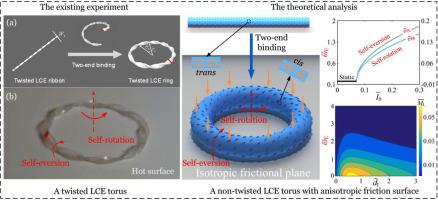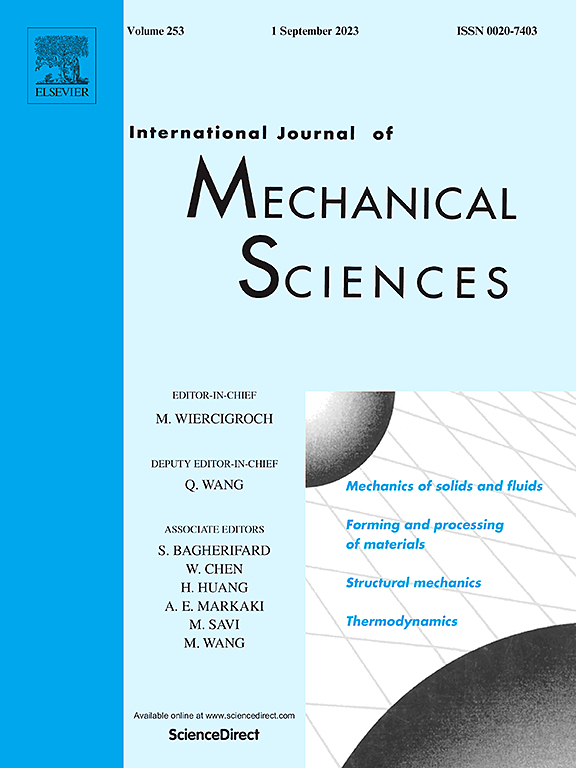各向异性摩擦面环面的自转-反转
IF 7.1
1区 工程技术
Q1 ENGINEERING, MECHANICAL
International Journal of Mechanical Sciences
Pub Date : 2024-07-22
DOI:10.1016/j.ijmecsci.2024.109584
引用次数: 0
摘要
最近的实验揭示了一种新型端对端带状螺旋结构,这种结构能够在恒温或恒定光源的作用下显示出两种相互连接的周期性零能动模式自旋转-倒转,但由于其复杂性,其制造具有挑战性。与此不同的是,本文通过在环体表面赋予各向异性的摩擦特性,在各向同性的摩擦平面上开发了一种以光为动力的自旋转和自翻转液晶弹性体环体。基于成熟的动态液晶弹性体模型,我们构建了环状系统的理论模型。环体能够吸收照明能量以抵消阻尼耗散,并产生零能量模式的自反转。理论研究结果表明,自转角速度受光照强度、光穿透深度、重力加速度和各向异性摩擦面的影响。此外,自转角速度和自转角速度之间存在比例关系,这是由各向异性摩擦面决定的。此外,还建立了自转方向的详细标准。理论研究结果表明了一些与实验观察类似的现象。本文提出了一种利用各向异性摩擦面控制自转-旋转的新的简单策略,对软机器人、有源器件和能量收集器的应用具有指导意义。本文章由计算机程序翻译,如有差异,请以英文原文为准。

Self-rotation-eversion of an anisotropic-friction-surface torus
Recent experiments have revealed a new end-to-end ribbon spiral structure capable of demonstrating two interconnected periodic zero-energy-mode self-rotation-eversion in reaction to constant temperature or constant light sources, yet its fabrication is challenging due to its intricate nature. Differently, this paper develops a light-fueled self-rotating and everting liquid crystal elastomer torus on an isotropic frictional plane, by imparting anisotropic frictional properties to the surface of the torus. Based on a mature dynamic liquid crystal elastomer model, we constructed the theoretical model of the torus system. The torus is capable of absorbing the illumination energy to counteract damping dissipation and produce zero-energy-mode self-eversion-rotation. Theoretical findings demonstrate that the angular velocity of self-eversion is influenced by light intensity, light penetration depth, gravitational acceleration and anisotropic friction surface. Moreover, there is a proportional relationship between the self-rotation and self-eversion angular velocities, which is determined by the anisotropic frictional surface. The detailed criterion for the self-rotation direction is also established. Theoretical findings exhibit several similar phenomena to experimental observations. This paper proposes a new simple strategy that utilizes anisotropic friction surface to control self-eversion-rotation, which has guiding significance for the application of soft robots, active devices, and energy harvesters.
求助全文
通过发布文献求助,成功后即可免费获取论文全文。
去求助
来源期刊

International Journal of Mechanical Sciences
工程技术-工程:机械
CiteScore
12.80
自引率
17.80%
发文量
769
审稿时长
19 days
期刊介绍:
The International Journal of Mechanical Sciences (IJMS) serves as a global platform for the publication and dissemination of original research that contributes to a deeper scientific understanding of the fundamental disciplines within mechanical, civil, and material engineering.
The primary focus of IJMS is to showcase innovative and ground-breaking work that utilizes analytical and computational modeling techniques, such as Finite Element Method (FEM), Boundary Element Method (BEM), and mesh-free methods, among others. These modeling methods are applied to diverse fields including rigid-body mechanics (e.g., dynamics, vibration, stability), structural mechanics, metal forming, advanced materials (e.g., metals, composites, cellular, smart) behavior and applications, impact mechanics, strain localization, and other nonlinear effects (e.g., large deflections, plasticity, fracture).
Additionally, IJMS covers the realms of fluid mechanics (both external and internal flows), tribology, thermodynamics, and materials processing. These subjects collectively form the core of the journal's content.
In summary, IJMS provides a prestigious platform for researchers to present their original contributions, shedding light on analytical and computational modeling methods in various areas of mechanical engineering, as well as exploring the behavior and application of advanced materials, fluid mechanics, thermodynamics, and materials processing.
 求助内容:
求助内容: 应助结果提醒方式:
应助结果提醒方式:


